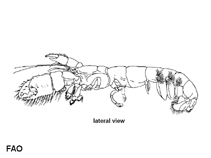| Family: |
Callianassidae (ghost shrimp) |
| Max. size: |
|
| Environment: |
benthic; freshwater; brackish; marine |
| Distribution: |
Eastern Central Atlantic: from the Ivory Coast to Congo. |
| Diagnosis: |
Rostrum very distinct and reaching beyond the cornea of the eyes; in adult specimens the rostrum ends in three or five large teeth of equal size. In juveniles the rostrum is a simple elongate narrowly triangular tooth which reaches beyond the middle of the eyes. The antennal angles are bluntly rounded and unarmed. The antennular peduncle reaches with about half of the third segment beyond the antennal peduncle. The third maxilliped has the merus and ischium widely expanded to form an operculum. Also the carpus (which is slightly longer than wide) and especially the propodus (which is much wider than long) are distinctly widened. The dactylus is very slender. The large first pereiopod of the female shows on the outer surface of the palm near the base of the fixed finger, a deep crescent-shaped depression with tubercles and spinules; this depression is not present in the males, where the anterior margin of the palm shows rather wide not too deep concavity. In both sexes the carpus of the larger leg is shorter than the palm. The merus has a short process in the basal part of the lower margin, which ends in a few small sharp teeth. The telson is slightly broader than long and is distinctly shorter than the elongate, roughly diamond-shaped endopod of the uropod. The lateral margins of the telson are convex. In adult specimens the posterior margin of the telson consists of three bluntly rounded lobes; in the young the posterior margin of the telson is about straight but for a median concavity. No spines are found on the telson (Ref. 4). |
| Biology: |
It has a total body length of 5.5 to 14.5 cm (Ref. 4). Habitat: It lives in burrows in the mud; it is found in estuarine areas, sometimes in practically freshwater (Ref. 4). |
| IUCN Red List Status: |
Not Evaluated (N.E.) Ref. 123251)
|
| Threat to humans: |
|
| Country info: |
|
Source and more info: www.sealifebase.org. For personal, classroom, and other internal use only. Not for publication.

